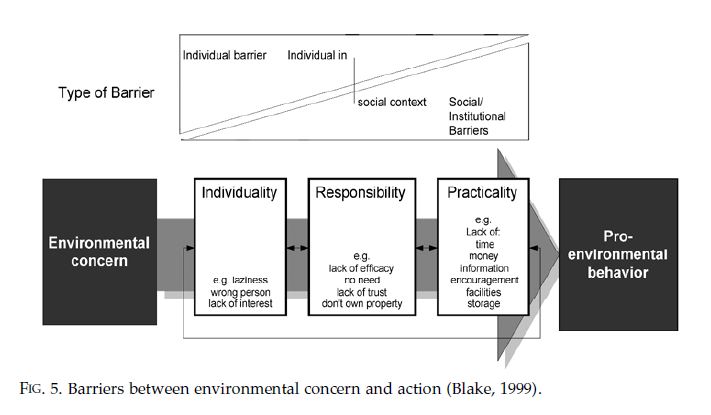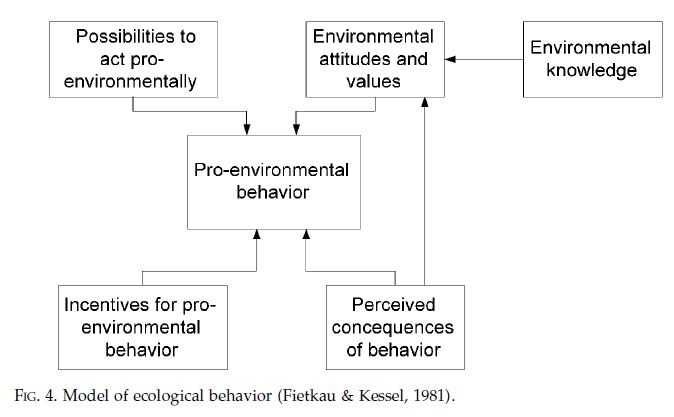Introduction
Shifting human behavior toward pro-environmental behavior is one of the most important challenges in addressing global environmental crises. Environmental psychology offers a toolbox of evidence-based strategies to promote behavioral change across different settings—from homes to cities to institutions.
Read More- Pro-Environmental Behavior
What is Pro-Environmental Behaviour (PEB)?
PEB refers to any behavior that consciously seeks to minimize the negative impact of one’s actions on the environment. This includes reducing consumption, conserving energy, recycling, and supporting sustainable policies. The goal is to make these actions not only easier but also habitual and socially expected.

Model of Pro-Environmental Behaviour
Proven Techniques to Promote PEB
Some proven techniques to promote PEB-
- Feedback and Smart Monitoring- Real-time feedback—like smart meters or water use apps—helps individuals adjust their behavior. Darby (2006) found that households receiving consumption feedback reduced their energy use by 5–15%.
- Commitment Devices- Public pledges or written commitments increase accountability and follow-through. Lokhorst et al. (2013) showed that individuals who made a formal commitment were more likely to engage in environmentally friendly actions over time.
- Incentives and Disincentives- Financial rewards (discounts, rebates) can jumpstart sustainable behavior. For example, offering public transit subsidies or energy-efficient appliance rebates nudges consumers toward sustainable options.
- Behavioral Prompts and Cues- Simple reminders like stickers near light switches or compost instructions on bins can significantly improve behavior. These cues reduce the need for constant conscious decision-making.
- Social Norms and Peer Influence- People tend to conform to what others are doing—especially when they believe those behaviors are approved. Highlighting peer behavior (e.g., “80% of residents recycled last week”) reinforces the norm (Cialdini, 2003).
- Changing Defaults through Choice Architecture- Making the environmentally friendly option the default—such as default double-sided printing or paperless billing—can significantly increase adoption rates with minimal resistance (Thaler & Sunstein, 2008).

Barriers to Pro-environmental Behavior
Challenges to PEB
Despite positive intentions, individuals face barriers such as:
- Perceived inconvenience or cost
- Lack of awareness or information
- Low perceived personal impact
Overcoming these requires context-sensitive approaches that are not only informative but also motivational and structural.

Model of Pro-Environmental Behavior
Conclusion
Encouraging pro-environmental behavior is a nuanced task that benefits from a combination of psychological insight and environmental design. By making sustainable behaviors easier, more rewarding, and socially desirable, communities can transition to greener habits. Policy, education, and design must work hand-in-hand to shape a more sustainable future.
References
Darby, S. (2006). The effectiveness of feedback on energy consumption. Environmental Change Institute, University of Oxford.
Lokhorst, A. M., Werner, C., Staats, H., van Dijk, E., & Gale, J. L. (2013). Commitment and behavior change: A meta-analysis and critical review. Environment and Behavior, 45(1), 3–34.
Thaler, R. H., & Sunstein, C. R. (2008). Nudge: Improving Decisions About Health, Wealth, and Happiness. Yale University Press.
Cialdini, R. B. (2003). Crafting normative messages to protect the environment. Current Directions in Psychological Science, 12(4), 105–109.
Niwlikar, B. A. (2025, April 25). 4 Important Techniques to Promote Pro-Environmental Behavior. Careershodh. https://www.careershodh.com/promote-pro-environmental-behavior/
